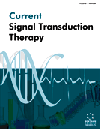- Home
- A-Z Publications
- Current Signal Transduction Therapy
- Previous Issues
- Volume 4, Issue 1, 2009
Current Signal Transduction Therapy - Volume 4, Issue 1, 2009
Volume 4, Issue 1, 2009
-
-
Exploiting Apoptosis Pathways for the Treatment of Pancreatic Cancer
More LessBy Simone FuldaEvasion of apoptosis (programmed cell death) is a hallmark of pancreatic cancer, one of the leading causes of cancer deaths in the western world. Resistance to apoptosis can promote the multistep process of tumorigenesis, since tissue homeostasis is disturbed by too little cell death. Further, defects in apoptosis programs can leads to treatment failure in pancreatic cancer, since intact apoptosis pathways are critical to mediat Read More
-
-
-
Recent Advances in the Signal Transduction Targeting of Colorectal Cancer: The Paradigm of Translational Medicine
More LessAuthors: Haralabos Kalofonos and Petros D. GrivasThe dynamic cross-talk between bench-based research and clinical practice is the fundamental characteristic of modern oncology. Colorectal cancer, the second most common cause of cancer-related death in the Western world, is the paradigm of the revolutionary use of targeted sophisticated therapies. The continuous unraveling of the molecular identity of signaling pathways that govern sub-cellular decisions rev Read More
-
-
-
Leptin Signaling: A Key Pathway in Immune Responses
More LessAuthors: Claudio Procaccini, Elaine V. Lourenço, Giuseppe Matarese and Antonio L. CavaLeptin is a hormone whose central role is to regulate endocrine functions and to control energy expenditure. After the discovery that leptin can also have pro-inflammatory effects, several studies have tried to address - at the molecular level - the pathways involved in leptin-induced modulation of the immune functions in normal and pathologic conditions. The signaling events influenced by leptin after its binding to the leptin rece Read More
-
-
-
Sonic Hedgehog Pathway as a Target for Therapy in Angiogenesis-Related Diseases
More LessHedgehog (Hh) proteins belong to a class of morphogens involved in many biological processes during embryonic development; they are relatively silent during normal adult life although they may be recruited postnatally in response to tissue injury. Three secreted proteins have been identified: Sonic hedgehog (Shh), Desert hedgehog and Indian hedgehog. The interaction of Hh ligand with its receptor Patched-1 triggers the activ Read More
-
-
-
The Role of Methionine Oxidation/Reduction in the Regulation of Immune Response
More LessAuthors: Abdulbaki Agbas and Jackob MoskovitzMethionine oxidation by reactive oxygen species and reduction mediated by the methionine sulfoxide reductase (Msr) system may attenuate protein function in signal transduction pathways. This review will focus on two potential protein targets for methionine oxidation involved in signal transduction of the immune response: Ca2+/calmodulin-regulated phosphatase calcineurin (Cn) and inhibitor of kappa B-alpha (IkBα). T Read More
-
-
-
Extracellular HSP90: An Emerging Target for Cancer Therapy
More LessAuthors: Katerina Sidera and Evangelia PatsavoudiCancer is a genetic disease which progresses from benign to malignant stages through the steady acquisition of genomic mutations in key cell-regulatory genes, namely oncogenes, tumor-suppressors, and stability genes. In many ways cancer is considered as a disease of de-regulated signal transduction. Oncogenic mutations frequently lead to overexpression and/or constitutive activation of signal transduction compon Read More
-
-
-
The Novel Role for Lyn in Integrin Signaling in Human Disease
More LessAuthors: Brian Tomkowicz and Andrzej PtasznikCell movement and adhesion serve critical roles in a wide variety of physiological situations, and when dysregulated can contribute to the pathogenesis of many diseases. Recently, Lyn kinase has emerged as a crucial regulator of ‘inside-out’ integrin signaling in hematopoietic cells, that when dysregulated, can lead to the development of an “invasive cell” phenotype in a variety of pathological contexts ranging from leuke Read More
-
-
-
Targeting Cyclooxygenase and Nitric Oxide Pathway Cross-Talk: A New Signal Transduction Pathway for Developing More Effective Anti- Inflammatory Drugs
More LessAuthors: Lizhi Liu, Summon Huq and Weiming XuCyclooxygenase (COX) and nitric oxide synthase (NOS) are two isoenzyme families that both implicated in the inflammatory process. Indeed, the activities of both enzymes are so important that two of the most important classic drugs, Aspirin and Nitroglycerin, are directly related to the COX pathway and NO pathway, respectively. Although Aspirin has been used as an anti-inflammatory drug since 1876, it was not until 1970s t Read More
-
Volumes & issues
-
Volume 20 (2025)
-
Volume 19 (2024)
-
Volume 18 (2023)
-
Volume 17 (2022)
-
Volume 16 (2021)
-
Volume 15 (2020)
-
Volume 14 (2019)
-
Volume 13 (2018)
-
Volume 12 (2017)
-
Volume 11 (2016)
-
Volume 10 (2015)
-
Volume 9 (2014)
-
Volume 8 (2013)
-
Volume 7 (2012)
-
Volume 6 (2011)
-
Volume 5 (2010)
-
Volume 4 (2009)
-
Volume 3 (2008)
-
Volume 2 (2007)
-
Volume 1 (2006)
Most Read This Month
Article
content/journals/cst
Journal
10
5
false
en


